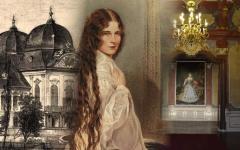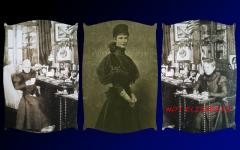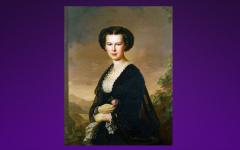ELISABETH’S BEAUTIFYING BATHS
Imperial beautifying bath recipes
Elisabeth, who was very famous for her beauty cult, had refreshing and slimming baths daily in order to preserve her beauty and youth. She combined steam and hot bath with cold one. She especially liked warm olive oil to make her skin delicate. The Empress’ niece, Countess Wallersee witnessed and recorded a case when her aunt nearly sacrificed herself on the altar of beauty:
"The oil was so heated that it was almost boiling and Elisabeth nearly met the terrible fate of the Christian martyrs!" /Chris Stadtländer, 38/

Empress Elisabeth by Franz Xaver Winterhalter (1865)
Initially, Sisi did not have a bathroom in the Vienna Hofburg, instead, like any other members of the imperial family, she got a porcelain basin which was placed in her bedroom. Of course, this was not enough for her so after her marriage, she got a wooden tub and later a wooden bathtub must have been provided for her. The Viennese court was appalled to hear that the young Empress had a daily bath while wearing nothing at all. Archduchess Sophie's court was controlled by the strict rules of the Spanish etiquette, which had been already outdated even that time. Sophie ruled as a “secret empress” so the Viennese court never really became Sisi’s one although she was the (actual) Empress.
Even if the steps taken by Elisabeth in order to preserve her beauty and youth provoked indignation from the Viennese court, they were not unique in Europe. Several high-ranked guests of the Emperor of Austria were startled by the lack of bathrooms in the Hofburg and Schönbrunn Palace.
Empress Elisabeth's bathroom in Hofburgban © Schloß Schönbrunn Kultur- und Betriebsges.m.b.H. / Alexander Eugen Koller

As mentioned above, the Viennese court was ruled by the laws of Archduchess Sophie, which might have been the reason why in the Hofburg Sisi had her bathroom - which was the most modern one that time - built only relatively late, in 1876. It might be important to note that Archduchess Sophie died in 1872. Sisi’s toilet was dolphin-shaped in Hofburg. The Empress was very fond of this motif: many of her personal belongings bore this motif including her cutlery - which can be seen in Sisi Museum, Hofburg - and some clothes of her wardrobe in Corfu.
Countess Marie Wallersee, Elisabeth’s niece was the daughter of her eldest brother, Louis and his wife, Henriette Mandel, the former actress. William Louis renounced his right of succession to the throne before marrying Henriette. This relationship caused a big scandal in the house of Wittelsbach, not only because of the morganatic marriage but also because of the fact that the couple had an illegitimate daughter, Marie Louise who was born on 24 February 1858.
Schönbrunn Palace © Schloß Schönbrunn Kultur- und Betriebsges.m.b.H. / Alexander Eugen Koller

Henriette Wallersee received the title of Baroness from the Emperor, however, she was never accepted by the upper class. Their daughter, Marie Wallersee, the later Countess Larisch became the confidant of Elisabeth partly because she was a great horsewoman but after the death (it is still debated whether it was a suicide or an assassination) of Sisi’s only son, the Crown Prince Rudolf, their friendship was spoilt forever. Anyway, this is another story.
The Life of Marie Louise Wallersee (picture video)
Imperial beautifying bath recipes
Finally, let us have some beautifying bath recipes from the Imperial Court Recipe Book.
Chris Stadtländer: Sisi császárné titkos szépségreceptjei - Secret Beauty Recipes of Empress Sisi, page 82-84. The book has not been translated into English.
Oriental luxury bath of Nofretete, Queen of Egypt (born ca. 1370 – died ca. 1330 BC)
1 litre of milk
1 cup of honey
2 tablespoons of pollen
Essence fragrance (e.g. amber, clove, sandalwood, orchid etc.).
Herbal bath (refreshes and invigorates blood flow and cleanses the pores)
Half a handful of the following: chamomile, peppermint, rosemary, lavender, sage, linden flower, fennel, hay flowers
Half a cup of honey
Water
Throw the herbs into boiling water after that leave the potion for an hour then drain and filter it. Press the liquid from the herbs then mix it with honey and pour it into the bath water.
Cleopatra's milk bath (for the soft and velvety skin) - Cleopatra, Egyptian Queen (born: 69 BC– died: 30 BC)
One and a half litre of milk
One and a half cup of honey
Pour it into your 36-39-degree bath water and enjoy your bath for 15-20 minutes.



Elizabeth Taylor as Cleopatra (1963), George Sand (Aurore Lucile Dupin) ; Ninon de l’Enclos
George Sand's beauty spa - Aurore Dudevant (1804-1876), best known by her pseudonym George Sand, was a French novelist and memoirist, who, like Sisi, loved beautifying baths.
300 grams of sea salt
2.5 decilitre of cream (whipped)
2 cups of honey
Ninon de l'Enclos 's honey and milk bath
Courtesan Ninon (1620 – 1705) was a French author, courtesan, freethinker, and patron of the arts.
500 g of salt (for dry skin put less salt, and add more milk)
1 litre of milk
1 cup of honey
Put the salt into the bathtub then fill that with hot water, and mix the heated milk with honey then add it to the bath water. Enjoy your bath for 15-20 minutes.
Visit Empress Elisabeth on Facebook.
In Hungarian: ERZSÉBET CSÁSZÁRNÉ SZÉPÍTŐ FÜRDŐI
Works Cited:Katrin Unterreiner. Sisi - Myth and TruthChris Stadtlaender. Sisi császárné titkos szépségreceptjei /The Secret Recipes of Empress Sisi - The book has not been translated to English/



